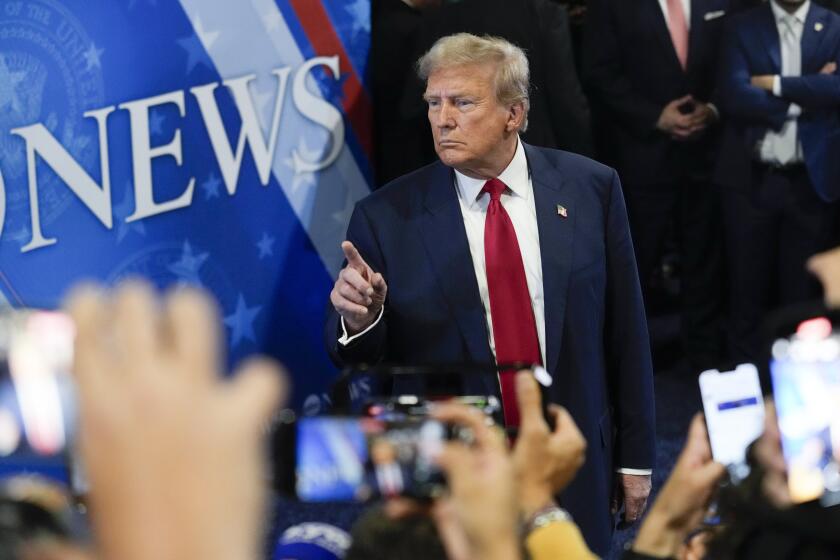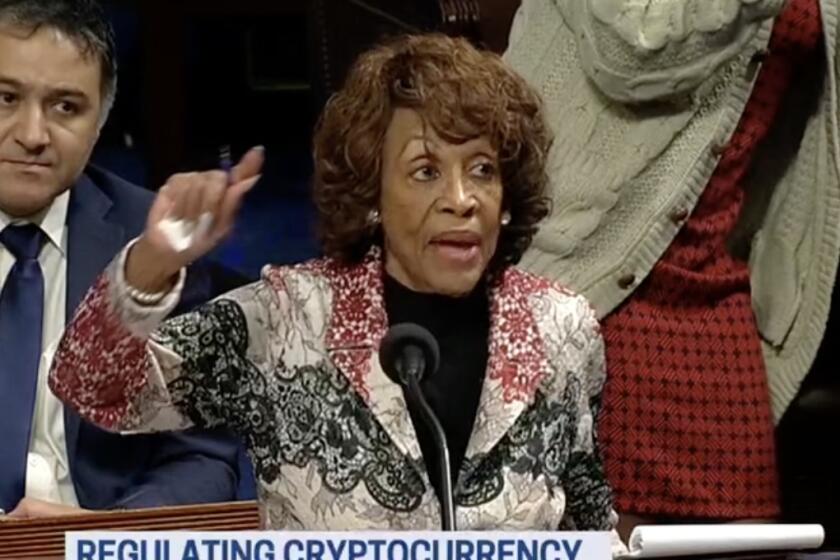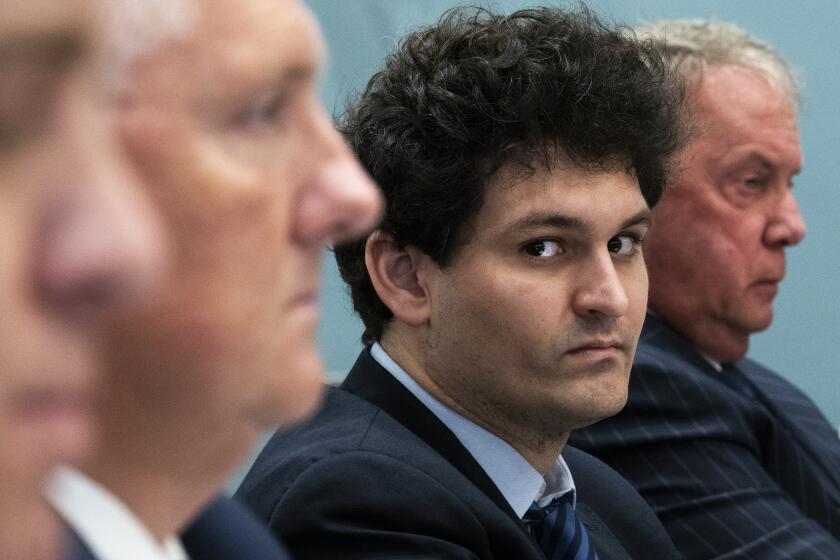Column: Suing to recover billions, FTXâs receiver discloses the stunning scale of its grift â and stupidity

Once the highest-flying of cryptocurrency highfliers, the FTX crypto exchange is now in bankruptcy. Its founder, Sam Bankman-Fried, is in prison, along with a couple of his cronies. Its customers will receive some of their money back, but are still toting up their losses.
You might think that all means an end to the FTX story. You would be wrong.
From Nov. 4 through Nov. 10, the current management of FTX â in essence, its receivers â filed 26 lawsuits to recover about $2 billion in payments made to former partners, investors, customers and philanthropies prior to the firmâs collapse.
Mr. Bankman-Fried continues to live a life of delusion. The âbusinessâ he left on November 11, 2022 was neither solvent nor safe.
— John Ray III, current FTX chief executive
This blizzard of filings in Delaware bankruptcy court tells quite a tale.
They document the efforts by Bankman-Fried and his fellow FTX insiders to turn themselves into political and financial big shots by spending billions of dollars entrusted to them by customers â the goal being âto enhance their own personal reputations at the expense of creditors,â as the current management puts it.
Get the latest from Michael Hiltzik
Commentary on economics and more from a Pulitzer Prize winner.
You may occasionally receive promotional content from the Los Angeles Times.
In the months before FTX collapsed and filed for bankruptcy court protection on Nov. 11, 2022, Bankman-Fried and his cohorts engaged in what the receivers call a âcampaign of influence-buyingâ in which Bankman-Fried made âlavish and showy âinvestmentsâ ... to project financial strength and stability,â including through hundreds of millions of dollars in contributions to charities and politicians and political action committees. Bankman-Fried resigned as CEO of FTX just before its bankruptcy.
The true purpose of this spending had been âto prop up Bankman-Friedâs standing in the worlds of politics and traditional finance,â the receivers assert. Those words come from their lawsuit to recover some $67 million in investments FTX made to SkyBridge Capital, a firm headed by onetime Trump White House advisor Anthony Scaramucci.
Those investments made âno economic senseâ for FTX, the receivers said. But they helped bail out Scaramucci and SkyBridge, whose cryptocurrency investments were failing. What Scaramucci offered Bankman-Fried, however, were âestablished financial, political, and social connections which included high-profile celebrities and wealthy investors around the world,â the receivers said.
A new FBI report says the U.S. is the world center of crypto fraud. Donald Trump and his family just announced a big crypto venture.
Indeed, once the investment closed, Scaramucci introduced Bankman-Fried to his contacts, including the crown prince of Saudi Arabia, much as the poet Virgil escorted Dante around the underworld in the Divine Comedy (if you know your medieval Italian literature). SkyBridge didnât respond to my request for comment.
The narrative embedded in these cases should send efforts to minimize Bankman-Friedâs criminality as the byproduct of a well-meaning but fatally distracted soul brought low by a temporary reversal in the crypto market to their final resting place.
The lawsuits underscore what FTXâs current CEO, John J. Ray III, told federal Judge Lewis A. Kaplan in March, rebutting Bankman-Friedâs assertion that no one lost money in the FTX collapse. In a memorandum, Ray wrote: âMr. Bankman-Fried continues to live a life of delusion. The âbusinessâ he left on November 11, 2022 was neither solvent nor safe.â
That reflects the governmentâs own sentencing memorandum. Bankman-Fried, the prosecutors wrote, âstole money from customers who entrusted it to him; he lied to investors; he sent fabricated documents to lenders; he pumped millions of dollars in illegal donations into our political system; and he bribed foreign officials.â
Kaplan sentenced Bankman-Fried to 25 years in prison. Among his accomplices, Caroline Ellison pleaded guilty to fraud charges and recently began a two-year prison term, and Ryan Salame pleaded guilty to conspiracy to make illegal political contributions, among other crimes. He was sentenced to 7½ years.
Much of this illegal behavior was facilitated by the fundamental sketchiness of cryptocurrencies as an asset class. The value of crypto token can be placed anywhere. They donât produce income like bonds, and their prices canât be pegged to liquid markets like those of public company securities. To this day, no one has ever explained what cryptocurrencies are useful for, other than paying ransom to crooks holding databases or computer systems hostage.
Cryptocurrency advocates are spending millions in political donations to obtain huge gaps in crypto regulations. Theyâre getting their moneyâs worth
As Iâve written previously, Bankman-Fried exploited the vacuity of crypto by slathering it over with what sounded like profundities but was vacuous gibberish. He could not have done so if there actually was anything genuine about crypto â his claims would have been weighed against market realities.
Why otherwise intelligent people, including political leaders and finance professionals, swallowed his spiel whole is the enduring mystery about Bankman-Fried and crypto.
The lawsuits filed by Rayâs team document the credulousness of those drawn into Bankman-Friedâs orbit. They bought his act as a shaggy sage in shorts and T-shirts, believed his claim that FTX was an almost uniquely âhonestâ crypto exchange and accepted his donations or invested their own, no questions asked.
You may have heard that a bankruptcy settlement recently approved by Bankruptcy Judge John T. Dorsey will allow FTX customers to recover all their losses.
Many customers wouldnât agree. Their deposits of cryptocurrencies with FTX were valued at the crypto prices on the date of the bankruptcy filing in 2022. Their holdings were converted to dollars at those prices, and that (plus interest) is what theyâll get back.
But the value of cryptocurrencies such as bitcoin has quintupled since then â bitcoin was worth $17,000 on the bankruptcy date, and close to $90,000 now, so the customers are deprived of any gain they might have pocketed had they been able to hold on to their coins.
The lawsuits seek recoveries from charities, conservative and progressive PACs, investors in FTX big and small, and other denizens of the crypto community. One of the latter is Nawaaz Mohammad Meerun, a crypto trader who has used the handle âHumpy the Whaleâ and who allegedly viewed FTXâs incompetent record-keeping as a flaw to be profitably exploited.
Customers of the bankrupt Celsius reveal how the cryptocurrency firmâs collapse upended their lives.
Meerun, according to the FTX lawsuit, bought a huge quantity of a lightly traded crypto token, driving its price up by 10,000%, then borrowed tens of millions of dollars from FTX using the tokenâs inflated value as collateral â even though manipulative trading was against FTX rules.
But Meerun was too big a customer and moved too fast for Bankman-Friedâs team to understand what was happening and freeze his accounts before he had drained them of more than $400 million, the lawsuit states. Meerun then staged at least two more raids on FTX using newly opened accounts, ultimately costing FTX about $1 billion, the FTX lawsuit says.
Meerun has denied FTXâs allegations, telling CoinDesk that he actually âencountered losses whilst trading at FTX.â
The biggest quarry in FTXâs lawsuits is Binance, the international crypto exchange that was once a major rival of FTX. Rayâs team says that a share-buyback deal in 2021 in which FTX paid Binance $1.76 billion was fundamentally fraudulent, designed chiefly to âsend a false signal of strength to the marketâ and funded largely by secretly raiding FTX customer deposits.
The lawsuit demands the fundsâ return; Binance hasnât yet responded. The exchange pleaded guilty last year to criminal violations of U.S. money-laundering laws. Its former CEO, Changpeng âCZâ Zhao, pleaded guilty to a money-laundering charge and completed a four-month prison sentence earlier this year.
Another Ray target is Crypto.com, the trading exchange that has paid to paste its name on the Los Angeles arena hosting the NBAâs Lakers and NHLâs Kings. The receivers say Crypto.com is holding $11.4 million in FTX funds that had been deposited with the exchange under a false name in order to conceal FTXâs involvement in trading on outside exchanges; despite months of effort by FTX, Crypto.com has refused to return the funds.
A Crypto.com spokesman told me by email that as far as itâs concerned, the funds in question belong to âpersons unaffiliated with FTX.â He said that âwe will handle this matter in accordance with the relevant law.â
Sam Bankman-Fried wanted to make cryptocurrency look legitimate. He only added to the evidence that itâs not to be trusted.
Concealment was a habit of FTXâs, according to the lawsuits. Political contributions to left-of-center or neutral PACs and charities were typically made in Bankman-Friedâs name.
Such contributions by right-wing or Republican entities and candidates were often made in the name of Salame or other FTX insiders âas straw donors to conceal the identity of the true donor, Bankman-Fried,â as FTX asserts in a lawsuit seeking the return of $3.5 million from the Senate Leadership Fund, a PAC devoted to securing a GOP Senate majority. (These sorts of donations were at the core of Salameâs criminal case.) The Senate Leadership Fund didnât respond to my request for comment.
Some recipients may have been blindsided by Rayâs demand for the return of contributions that were originally made in 2021 or 2022, when Bankman-Fried was trying to build up his stature.
One is FWD.us, a bipartisan reform organization co-founded by Meta Chairman and CEO Mark Zuckerberg and other technology business leaders in 2013. The FTX lawsuit seeking the return of $1.8 million donated in 2021 and 2022 came as a bolt from the blue when it was filed on Nov. 8, possibly because an emailed heads-up warning from Rayâs team went astray.
The donations nominally came from Guarding Against Pandemics, a healthcare reform organization headed by Bankman-Friedâs brother, Gabriel. But the ultimate source of the funds was an account containing FTX customer funds, the lawsuit says. That was news to FWD.us, its president, Todd Schulte, told me.
âIâve never spoken to anyone at FTX,â he said. He added that FWD has reached out to the FTX team to work out how to resolve the claim. Zuckerberg is not an officer or board member of the organization, Schulte says, though he still provides some funding.
What does all this litigation tell us? Itâs that crypto was, and remains, a massive scam. Itâs a field in which criminality is âpervasive,â as the FBI reported in September. If the lessons of the FTX collapse are forgotten, there will be a few who will be winners, and many more who will be losers.
More to Read
Get the latest from Michael Hiltzik
Commentary on economics and more from a Pulitzer Prize winner.
You may occasionally receive promotional content from the Los Angeles Times.















